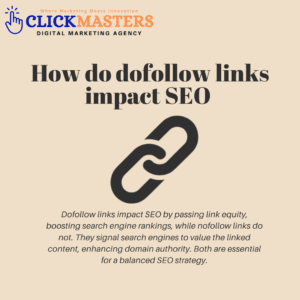Dofollow links impact SEO by passing link equity, helping improve a website’s search engine rankings. Unlike nofollow links, they signal search engines to consider the linked content valuable. Building quality dofollow backlinks boosts domain authority and organic visibility. Effective use of dofollow links can enhance SEO strategies significantly. Focus on acquiring relevant dofollow links for maximum SEO impact.
A dofollow link is a standard hyperlink that passes on link equity (also known as “link juice”) to the target page. This means that when another website links to your content using a dofollow link, it informs search engines like Google that your page is relevant and authoritative. This transfer of link equity helps improve the linked page’s search engine ranking and increases its visibility.

How Dofollow Links Impact SEO:
- Boost Rankings: Dofollow links help improve the target page’s SEO by transferring link equity (PageRank) from the referring website to the destination page.
- Increase Website Authority: When your website receives high-quality dofollow backlinks, Google views it as more authoritative and relevant, which can result in better rankings.
- Organic Traffic Growth: As your rankings improve with more dofollow backlinks, you are likely to see an increase in organic traffic, bringing more visitors to your website.
What Are Nofollow Links?
A nofollow link, on the other hand, contains a special HTML attribute (rel=”nofollow”) that tells search engines not to pass any link equity or PageRank to the linked page. Essentially, these links don’t impact the SEO of the destination page directly. However, nofollow links can still bring traffic and help maintain a healthy, diverse backlink profile.
How Nofollow Links Impact SEO:
No Direct SEO Benefit: Nofollow links do not pass link equity to the linked page, meaning they don’t directly help with rankings in search engine results.
Traffic Generation: While nofollow links don’t affect SEO directly, they can still generate traffic if they appear on high-traffic websites or blogs.
Diversity of Link Profile: A mix of dofollow and nofollow links creates a more natural backlink profile in Google’s eyes. Too many dofollow links can look suspicious, but having a balance of both types is seen as more organic.
Google’s Guidelines for Dofollow and Nofollow Links
Google has clear guidelines about when and how to use dofollow and nofollow links:
- Dofollow Links: These are the primary links that Google values for ranking purposes. Google uses these links to evaluate a website’s authority and relevance concerning search queries. If you want a link to affect your ranking, it should be a dofollow link.
- Nofollow Links: Google states that nofollow links are not a ranking signal and should be used for specific cases like:
- Paid Links: To comply with Google’s rules on paid link practices.
- User-Generated Content: To avoid the risk of spam links.
- Untrusted or Sponsored Content: When you don’t want to endorse the content or pass PageRank.
Key Differences Between Dofollow and Nofollow Links
Aspect Dofollow Links Nofollow Links
SEO Impact Pass link equity, improving rankings No direct impact on rankings
Link Value Contributes to PageRank and authority Does not contribute to PageRank.
Purpose Used for valuable, natural backlinks Used for paid ads, user-generated content, comments
Traffic Can increase organic traffic by improving rankings Can bring traffic if on high-traffic sites.
Google’s Opinion A key ranking signal for Google is Not a ranking signal but helps diversify link profiles.
Why Both Types of Links Matter
Google’s algorithms consider a natural backlink profile when evaluating a website’s authority. A mix of dofollow and nofollow links ensures that your website’s link profile looks organic and free of manipulative practices. While dofollow links can directly boost SEO, nofollow links can bring traffic, create diversity, and prevent spammy practices from affecting your rankings.
Best Practices for Using Dofollow and Nofollow Links in SEO
Use Dofollow Links for Organic Backlinks: Aim to get dofollow links from authoritative sources, as these will directly help boost your rankings.
Use Nofollow Links for Paid or Untrusted Links: Always apply the nofollow attribute for paid ads, affiliate links, or user-generated content to comply with Google’s guidelines.
Maintain a Balanced Link Profile: Google appreciates diversity in backlinks. Too many dofollow links might seem unnatural, so having a combination of both dofollow and nofollow links is ideal.
Focus on Quality Over Quantity: Whether dofollow or nofollow, focus on acquiring high-quality backlinks that come from relevant and trustworthy websites.
Conclusion:
Dofollow vs Nofollow Links for SEO
In the debate of dofollow vs nofollow links for SEO, both types of links play important roles, though they serve different purposes. Dofollow links are vital for improving rankings and authority, while nofollow links provide indirect benefits such as driving traffic and maintaining a diverse, natural backlink profile.
By understanding how each link type impacts your SEO and following Google’s guidelines, you can create a well-rounded backlink strategy that maximizes your website’s performance in search engine results. Always prioritize quality backlinks and maintain a healthy mix of dofollow and nofollow links for the best results in your SEO efforts.
FAQ, S
What are dofollow and nofollow in SEO?
Dofollow links pass SEO value to the linked website, helping it rank higher in search engines.
Nofollow links do not pass SEO value and prevent search engines from following the link.
how do post dofollow and nofollow links?
To post a dofollow link, simply add a regular hyperlink without any special attributes. For a nofollow link, add the rel=”nofollow” attribute in the HTML code of the link.
What is the difference between dofollow and nofollow links?
Dofollow links pass link equity, helping improve a website’s SEO and search engine rankings. Nofollow links, on the other hand, include a “rel=’nofollow'” attribute, instructing search engines not to pass link equity. Dofollow links contribute to domain authority, while nofollow links are often used for untrusted or sponsored content. Both types of links are important for a balanced backlink profile. Using them strategically can enhance SEO while maintaining compliance with search engine guidelines.








